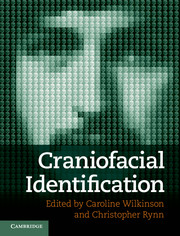Book contents
- Frontmatter
- Contents
- Contributors
- Part I Identification of the Living
- Chapter 1 Familiar face recognition
- Chapter 2 Unfamiliar face recognition
- Chapter 3 EFIT-V
- Chapter 4 Facial recall and computer composites
- Chapter 5 Facial ageing
- Chapter 6 Age progression and regression
- Chapter 7 Computer-assisted age progression
- Chapter 8 Facial recognition from identification parades
- Chapter 9 Virtual human identification line-ups
- Chapter 10 Computer-generated face models
- Chapter 11 Recognising and learning faces in motion
- Chapter 12 Facial image comparison
- Chapter 13 Three-dimensional facial imaging
- Part II Identification of the Dead
- Index
- Plate Section
- References
Chapter 4 - Facial recall and computer composites
Published online by Cambridge University Press: 05 May 2012
- Frontmatter
- Contents
- Contributors
- Part I Identification of the Living
- Chapter 1 Familiar face recognition
- Chapter 2 Unfamiliar face recognition
- Chapter 3 EFIT-V
- Chapter 4 Facial recall and computer composites
- Chapter 5 Facial ageing
- Chapter 6 Age progression and regression
- Chapter 7 Computer-assisted age progression
- Chapter 8 Facial recognition from identification parades
- Chapter 9 Virtual human identification line-ups
- Chapter 10 Computer-generated face models
- Chapter 11 Recognising and learning faces in motion
- Chapter 12 Facial image comparison
- Chapter 13 Three-dimensional facial imaging
- Part II Identification of the Dead
- Index
- Plate Section
- References
Summary
Introduction
Imagine, if you will, that you are sitting quietly outside a café sipping your favourite hot beverage when someone rushes past and snatches your mobile phone, which you left on the table, as you often do. You were able to get a good look at the person’s face, albeit for a short time. Your next hour is spent speaking with a police officer giving a description of what happened and what the offender looked like.
It is likely that you could describe accurately what happened. You will probably also be able to describe the perpetrator’s build and clothing. There should be no trouble in saying what was the sex of the person and his or her ethnicity; you should be reasonably accurate at estimating the age, height and weight. You could probably remember some details of the person’s face.
- Type
- Chapter
- Information
- Craniofacial Identification , pp. 42 - 56Publisher: Cambridge University PressPrint publication year: 2012
References
- 10
- Cited by



